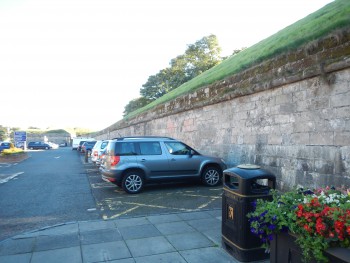- Navigation:
- Back to the Corpus index page
- RSS
Berwick St Mary Parish Church
Berwick-upon-Tweed, St Mary's Church, possible site of church outside wall
- Dedication: Our Lady
- Diocese of St Andrews
- Deanery of Merse
Summary description
Demolished to make way for the fortifications of the burgh in 1558.
Historical outline
Dedication: Our Lady
Around 1136, as he prepared the way for the foundation of his Cistercian abbey at Melrose, King David I granted the monks of Durham the church of St Mary of Berwick in exchange for the monks’ lands and rights at Melrose.(1) Durham’s possession was confirmed between 1163 and 1178 by Richard, bishop of St Andrews, in his general confirmation of the properties of the monks in his diocese.(2) Following the cession of the church of Berwick St Laurence to Durham by the monks of Kelso it appears to have been united with St Mary to form the parish of Bondington and, in turn, this united parish was merged in the fourteenth century with that of Berwick Holy Trinity.(3)
Notes
1. Charters of David I, ed G W S Barrow (Woodbridge, 1999), no.52.
2. J Raine, The History and Antiquities of North Durham (London, 1852), Appendix, nos xviii, cccclvi.
3. Raine, North Durham, Appendix, nos ccccliii-cccclvi, dcxliii.
Architectural description
The church of Berwick St Mary was granted to Durham Cathedral Priory at a date between 1130 and 1133 by David I, in exchange for the church of Melrose, which was itself then granted to David’s recent foundation for the Cistercians there. Following the exchange, the church at Berwick was devoted by Durham to the uses of its daughter priory at Coldingham; it was subsequently confirmed to Durham by Bishop Richard of St Andrews (1163-78). By the fourteenth century it appears that the parish had been united with that of Holy Trinity.(1)
Some confusion has been caused by the indications that there may have been a church with a dedication to St Mary associated with the parish of Bondington, which is assumed to have been to the north west of Berwick itself. This has led one author to suggest that the St Mary’s Church in Berwick was one of two churches that served Bondington parish (the other being dedicated to St Laurence) before all of the churches involved eventually merged with that of Holy Trinity.(2)
The alternative view has been offered, however, that the St Mary’s Church associated with Bondington was entirely distinct from the parish church with that dedication in Berwick, and that it was a non-parochial foundation rather than the church of that dedication in Berwick. It is a possibility that its church was a Romanesque apsidal structure that has been located through excavation at 21 Castle Terrace in 1998, with the further possibility that it was attached to a leper hospital.(3)
The parish church of St Mary in Berwick was demolished to make way for the construction of the bastioned fortifications along the north-west and east sides of the burgh, which excluded the northern parts of Berwick. This work was started in 1558, under the supervision of the engineer Sir Richard Lee.(4) The consequent loss of capacity for worshipers has been taken to be one reason why it was eventually found necessary to rebuild Holy Trinity Church on a larger scale in 1650-52.
St Mary’s Church is assumed to have been located at the head of St Mary’s Gate, in the north-western part of the burgh, and to the east of the castle. It has been suggested that it may have been located immediately outside the Elizabethan defences, between Scotsgate and the Cumberland Bastion. If that is the case, however, the discovery in or about 1982 of skeletal remains to the south-east of that site,(5) and within the defences, may suggest that the defences cut through the churchyard.
Notes
1. Ian B. Cowan, The Parishes of Medieval Scotland (Scottish Record Society), 1967, pp. 17 and 146.
3. Eric Cambridge, Tim Gates and Alan Williams, ‘Berwick and Beyond: Medieval religious Establishments on the North Western Margin of Berwick-Upon-Tweed – Problems of Identity and Context’, Archaeologia Aeliana, ser. 5, vol. 29, 2001, pp. 36-64, 77-78.
4. An account of the construction of those defences is given in H.M. Colvin et al., The History of the King’s Works, vol. 4, London, 1982, pp. 644-64.
Map
Images
Click on any thumbnail to open the image gallery and slideshow.





